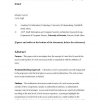Free Online Productivity Tools
i2Speak
i2Symbol
i2OCR
iTex2Img
iWeb2Print
iWeb2Shot
i2Type
iPdf2Split
iPdf2Merge
i2Bopomofo
i2Arabic
i2Style
i2Image
i2PDF
iLatex2Rtf
Sci2ools
INTR
2007
2007
Web services access control architecture incorporating trust
Purpose – This paper seeks to investigate how the concept of a trust level is used in the access control policy of a web services provider in conjunction with the attributes of users. Design/methodology/approach – A literature review is presented to provide background to the progressive role that trust plays in access control architectures. The web services access control architecture is defined. Findings – The architecture of an access control service of a web service provider consists of three components, namely an authorisation interface, an authorisation manager, and a trust manager. Access control and trust policies are selectively published according to the trust levels of web services requestors. A prototype highlights the incorporation of a trust level in the access control policy as a viable solution to the problem of web services access control, where decisions of an autonomous nature need to
| Added | 15 Dec 2010 |
| Updated | 15 Dec 2010 |
| Type | Journal |
| Year | 2007 |
| Where | INTR |
| Authors | Marijke Coetzee, Jan H. P. Eloff |
Comments (0)

